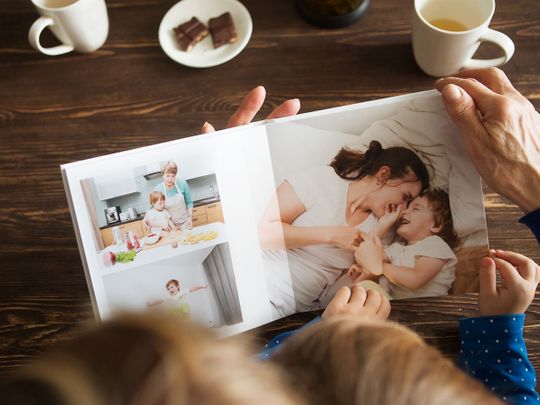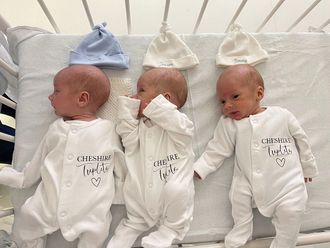
To be a more conscious parent, you might need to confront your own past. One way of doing that is through old photos.
“There are different ways to trigger childhood memories. These could be scents, sounds, locations, photographs, etc.,” says Bene Katabua, Educational Psychologist at Intercare Health Center in Abu Dhabi.
“In psychotherapy, we recognise the necessity of creating safe spaces for people to explore the effects of our childhood. Having these sensory recollections can open up a world of memory - both positive and negative. However, because relying solely on memory isn't always completely reliable - it can be easy to invalidate at times. Holding onto particular objects, photographs, memories, journal entries, ticket stubs, etc. can help not only access the memory but also validate that certain events happened,” she adds.
Why do we bury old memories?
As life carries on and the memories stack up one upon another, there is great chance of the oldest fading. Plus, there’s the fact that the brain tends to add recall value more to the traumatic moments than it does the happy ones. This might be an evolutionary development, says a study conducted in 2007, published in peer-reviewed journal ‘Current Directions in Psychological Science’. Researchers say negative emotions such as fear and sadness trigger increased activity in the part of the brain linked to memories. These emotionally charged thoughts are preserved in greater detail than happy or more neutral memories, but they may also be subject to greater distortion, explains an article on Web MD.

Some people look back at childhood years with fondness and recall events with distinct detail, whereas others often comment about not remembering particular childhood experiences. In some instances, the lack of childhood memories may be linked to adverse childhood experiences whereby the brain represses certain traumatic details to preserve itself.
The blanking out may also be a defence mechanism. “Some people look back at childhood years with fondness and recall events with distinct detail, whereas others often comment about not remembering particular childhood experiences. In some instances, the lack of childhood memories may be linked to adverse childhood experiences whereby the brain represses certain traumatic details to preserve itself. In other instances, forgetting early childhood memories is typical as memory storage and retrieval develop over time,” explains Katabua.
The memories we do have – whether in a subconscious or conscious space – is what determines how we navigate life. “We mirror what is familiar to us from our childhood; what we’ve learned from our childhood we will project into our current reality. That is generational trauma,” says Luz Maria Villagras S., a UAE-based Conscious Parenting Coach, Hypnosis Therapist and Neuro-Linguistic Programming Practitioner.
The past shapes our future
“Although we may not have verbal recollections of particular events, the body tends to keep a score of our early childhood memories. We recognise this in our patterns - be it in relationships, coping mechanisms, recurring illnesses, etc. Our body often finds ways to either repeat certain memories or repress them. Neither of these is particularly helpful, and attempts should be made toward healing instead of the alternatives presented above,” Katabua adds.
The good news is that some generational handovers are actually positive. “When you see pictures of your childhood, if they are good memories, it will help you to remember the good moments. You recall the moments [you may have forgotten],” says Maria Villagras S. It has a mood-elevating effect. “But the most interesting thing is not the picture itself, it is the significance of it and the lessons it possesses.”
If, for instance, says Maria Villagras S., you find a photograph of yourself with your grandmother, you may remember the time you spent with her, the love you felt for her and you can use the photograph to introduce your little one to those values of respect and familial gratitude.

You might remember that when you were a child and your mother used to do certain things for you, they made you happy. But that was you. But now you have a child. He or she is unique. You can do the same things your mum did and expect for him or her to react the same way, but they are not you. They have their own personalities and needs.
Some photographs can also bring closure to a conscious parent. “So you might remember that when you were a child and your mother used to do certain things for you, they made you happy. But that was you. But now you have a child. He or she is unique. You can do the same things your mum did and expect for him or her to react the same way, but they are not you. They have their own personalities and needs.” Keeping an open mind while engaging in memory recall can help you connect the dots and so be a more present, more conscious parent.
How to use a photograph to reconnect with your past
To understand where your strategies stem from, you must reach into the past to analyse your childhood. Jasmine Collin, a Dubai-based conscious parenting coach, offers the following exercise for insight into yourself:
1. Make sure you are feeling safe and won’t be disturbed before doing this reflective exercise.
2. Get cosy, dim the lights and switch off your phone.
3. Have a pen and paper ready to journal as well as a photo of yourself as a young child.
4. Sit and look at the photo for three to five minutes.
5. Imagine what it was like to be that child.
6. Now, answer these questions:
- What was it like growing up for this child?
- How did he or she feel growing up?
- What do you wish your parents knew about you back then?
- What needs were your parents not meeting?
- What did you need more of?
- If you could change anything about your childhood, what would it be?
Once you have these answers, you know what negatives to look for in your own behaviour and the shadow that looms over your parenting style. You can then choose to keep or rid yourself of it.
A word of caution if you’ve had a rough childhood. “If,” says Collin, “You have a history of physical or emotional abuse, I strongly recommend you don’t do this exercise alone and you seek out a trained therapist.”

If you have a history of physical or emotional abuse, I strongly recommend you don’t do this exercise alone and you seek out a trained therapist.
The process of learning about your memories and triggers may be difficult but also it can be healing. “The memories that are triggered may not always be positive ones, but processing them can bring about a sense of healing and closure. In some instances, the memories brought up can be joyful and warm, and can be used as motivation towards a goal to find ways in which to bring up similar sensations again in adulthood. Either way, having the ability to look back can have a tremendous effect on our ability to move forward,” Katabua adds.
When you know your own triggers, the weight of a child’s behaviour will stop warranting rage and displeasure. You’ll be able to see it for what it really is – just a kid being a kid. The cycle of generational trauma handovers will break.
Have a topic you'd like us to cover? Write to us at parenting@gulfnews.com








